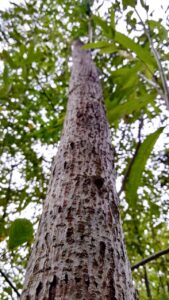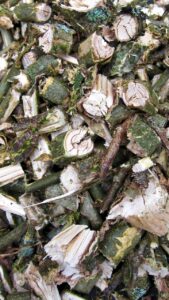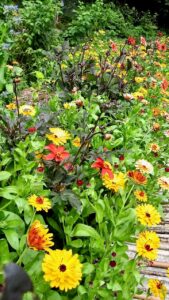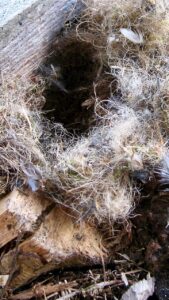Compost fodder, plant support, greenhouse shading, mulching material, soil enricher, winter fuel, garden screen, wildlife haven… there’s no end to the potential of the versatile willow.
Our first stormy autumn night didn’t disappoint: warm, lashing rain, high, cottage-shaking winds and two mini power cuts – then a proper time-for-bed blackout.
My head torch-illuminated check outdoors revealed a drowned, flattened garden, dazzling stars between the downpours – and some willows behaving rather badly. Whipped to and fro by the wild wind, said Salix stems were brushing against our power lines, so emergency midnight pruning beckoned. The 4m-long stems were duly toppled by torchlight (and no, they weren’t the cause of the lights going out).

The following morning, the stack of downed stems sang with possibilities. Leafy green mulch? Sappy ‘greens’ for composting? Green wood chips to feed my no-dig soil? Logs to season for our wood burner? Thinner logs for a wildlife pile? Big metre-long cuttings to establish new plants (or make a living ‘fedge’)? Taller stakes and twiggy shoots to set aside to dry and die, ready for next year’s plant supports? Fast-grown potential beckoned.
My willow worship began 20 years ago, when I collected some big – I’m talking 1m to 2m long – hardwood ‘cuttings’ from local wild trees. I pushed them into crowbar-made holes to about a third of their length, along part of the garden’s perimeter, for both screening and, in time, some winter fuel.
The wild plants duly rooted, spurring me on to plant named willow varieties in other spots, including fast-growing varieties – the culprits in need of the midnight chop. I never imagined how those seemingly lifeless, dormant sticks (from The Willow Bank) would reward me, over two decades, in multiple ways.
Above all else, my willows are simply sleek, graceful and beautiful, whatever the season. They dance to the slightest breeze, burst into fresh green in spring, give dappled summer shade, then depart in mellow autumn yellows (which become leaf mould).

Bees set their shoots buzzing in spring, when the catkins open. Weeks later, their minuscule seeds (which can germinate in hours) become a pale silky blizzard on warm, dry days. Blackcaps, wrens and tits flit through their dense foliage, safe(ish) from patrolling sparrowhawks; willow sawflies (Nematus ventralis) munch quietly on their leaves.
In winter, their colourful bark catches the shy sun, and at solstice I cut multicoloured armfuls of pliable stems to weave into beautiful and totally rottable wreaths and other arrangements.
My early, storm-induced harvest of stems thick and thin needs divvying up. The thinner, still leafy and sappy green shoots are heading for the shredder, where they’ll chop down, either for mulch or as greens for the compost bins and heaps.
Woodier shoots under about 25mm in diameter will also get shredded; these green wood chips will get forked into the top few centimetres of my no-dig beds – where they’ll nourish soil life and build dark, carbon-sequestering humus. Or I’ll pile them up to break down; fungi will quickly move in, feasting on their sappy succulence, leaving me with a pile of brown chips to use in home-made peat-free potting mixes come spring.

Stems 25mm or more thick will keep me fit and our home warm. Cut to 25cm lengths, thick logs will be split and stacked outdoors to season for around 18 months. During that time, they’ll be home to anything from spiders, hibernating butterflies and wasps to treecreepers, which sometimes mould their soft cosy nests into the dry nooks and crannies, and sunbathing lizards, which use the crevices as bolt holes.
The carbon the logs have squirrelled away will be set free again when we burn them – burning home-grown is about capturing and then releasing carbon – but willows, along with the hazel and oak prunings I turn into green wood chips, convey some of theirs into long-term storage in the soil, as humus. On their way, the chips will inject any flagging soil with new life, as fungi and other soil micro-organisms set about feasting on them.
Soft and sappy wood chips are packed with plant foods, amino acids, enzymes, minerals and proteins, which all get unleashed into the soil as they’re deconstructed by decay, ready for plant roots to tuck into. The results here have been dramatic: a few months after adding green willow wood chips to one of my no-dig beds, I was treated to flush after flush of toadstools sprouting from a network of underground mycelium garlanding the buried, decomposing chips. Plants in that bed grew like the clappers, some with toadstools sprouting from among their roots. (It’s an enduring mystery why more folk are not talking about this and experimenting with it themselves.)
Willows grow like the clappers themselves. My fastest-growing, reach-for-the-sky variety, which triggered the midnight pruning, is Salix viminalis or osier, a vigorous native willow that grows before your eyes. I encourage lots of vigorous sappy shoots by pollarding, a perfect job for a cold winter’s day.

If the pollarded stems get left lying around for too long, they’ll take root – even just laid on the ground. That’s why cut willow is only good as a plant support when it’s dead; unlike its superpowered rival hazel, if you push even thin, fresh-cut willow into soil, it’ll rapidly root and grow. I set thick and twiggy supports aside for at least six months to dry out before using them (they keep better in the dry).
If I’m going to need stouter, longer stakes, I cut those a summer ahead, but they earn their keep straight away. It still seems wrong when I cut long, leafy shoots in their summer prime, but they make instant, effective, plastic-free shading for my greenhouse – especially when I’m caught on the hop by scorching days. The shoots are easy to remove once the sunburst ends; they can either be kept to dry out for later use, or shredded for mulching or composting.
Dead, dried willow is utilitarian, but fresh, live willow unlocks the imagination. As the winter solstice looms, I get secateur-happy, cutting bright, thin and flexible shoots ready for some seriously simple weaving. I make wreaths, rings or swirls, decorated with storm-downed lichens, holly and ivy, all held together using compostable raffia, jute twine or bindings of wild honeysuckle. Salix alba var. vitellina ‘Britzensis’ (orange-yellow bark) and Salix daphnoides (black stems) are my two favourites for therapeutically weaving worries away.

Their spirited growth above ground is matched underground by willows’ extensive, searching root systems. Their lust for life means they should never be planted near houses, outbuildings, walls or septic tanks and drains – water-seeking roots can disturb and damage. Here, I have the luxury of gardening on the edge of untamed wild nature. Unless you are similarly located or have a larger garden, willows should be planted with careful forethought.
But if we engage some outside-of-the-garden thinking, there’s no reason why every gardener can’t tap into the willow’s renewable wonders. What if awkward areas or strips of allotment or community garden sites were set aside for growing willow? They thrive in soils where other plants fear to root. Or how about creating more urban, willow-anchored swales to help buffer the impact of increasingly extreme rain and storm events, whose effects are often most severe in the very places where most of us live and garden?

Willow ‘banks’ could become a community resource; anyone could cut what they needed, whether it was a few armfuls of leafy shoots to chop into summer mulch or green wood chips, thicker shoots for next year’s runner bean poles, some insta-shading, or whippy shoots for weaving. Communal winter pollarding and/or coppicing days would yield camaraderie, but also raw, renewable greens for composting; they could build the take-what-you-need mulch mound, and supply big, easy-to-plant cuttings for anyone to have. In summer, children could run with wild, shrieking joy through a maze of woven willow tunnels they’d planted and then plaited together themselves.
These verdant, shady banks would be filled with life; willow is on a par with oak in terms of the number of insect species it supports, meaning good food news for birds. Other wild lives would unfold in their cool, dappled shade. Willow banks would help clean our air, soak up rain, slow flooding, create sound and movement, and bring brightness to dingy winter days.
This willow bank idea has given me the urge to add to my own stocks of Salix. Now, where’s that crowbar… ?
Text and images © John Walker
Find John on X (formerly Twitter) @earthFgardener










